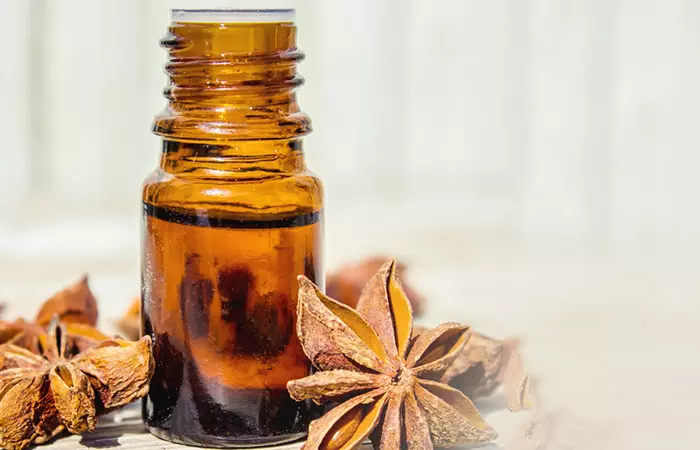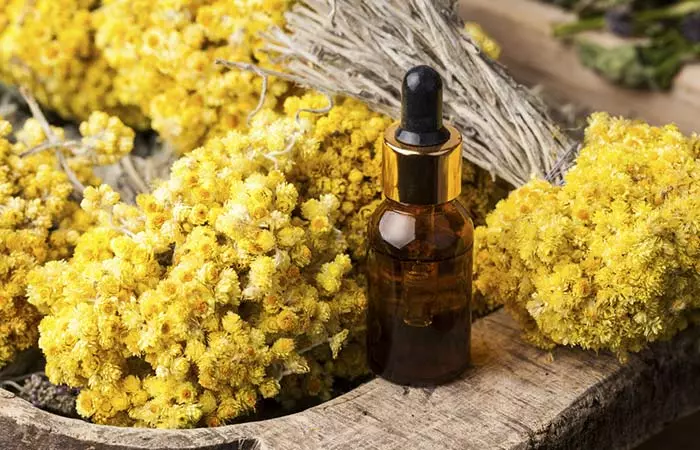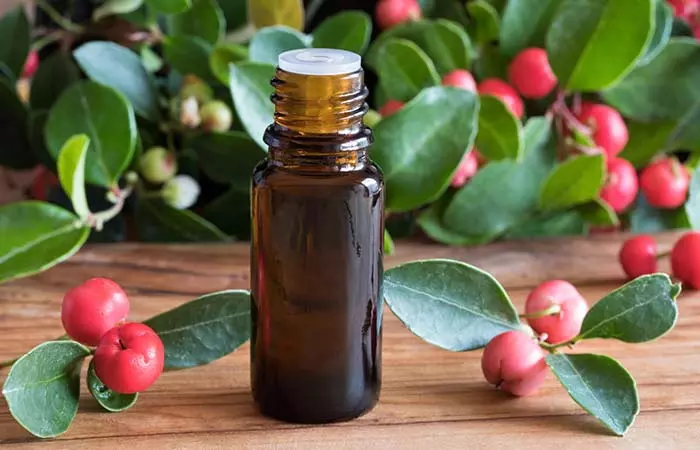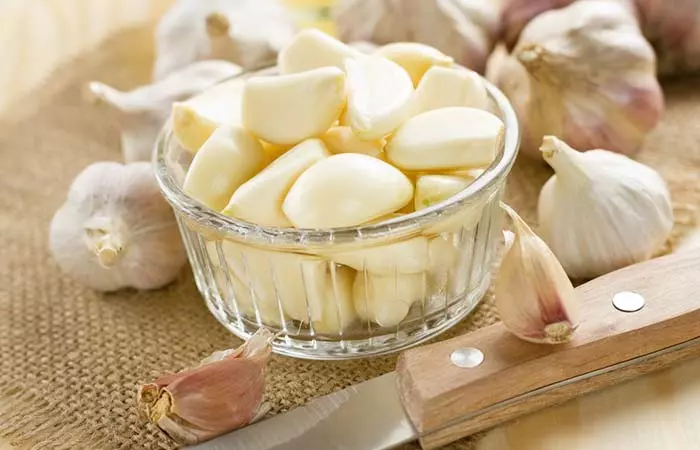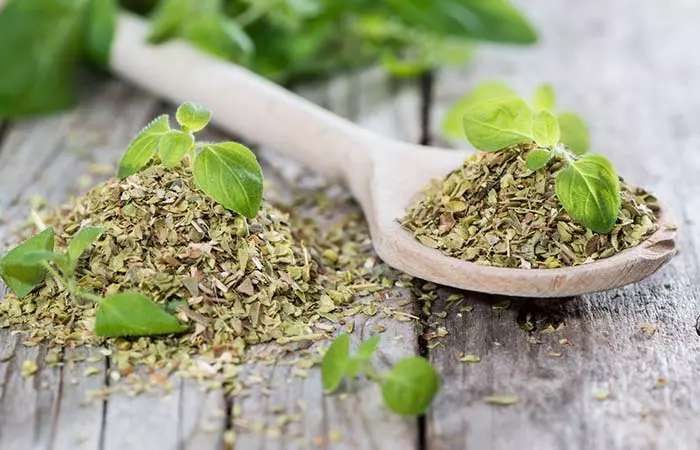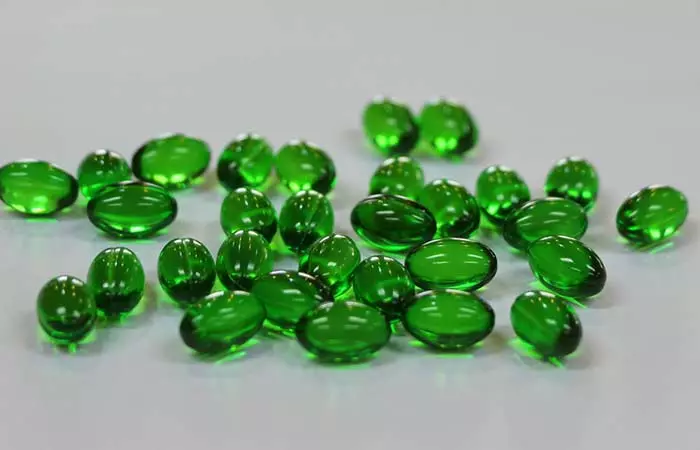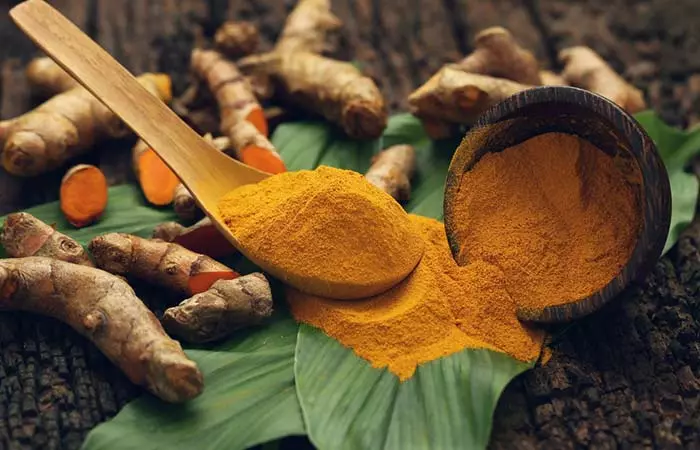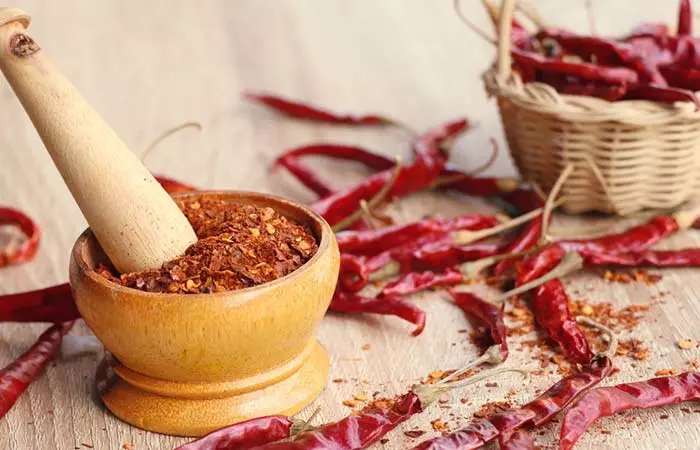How To Get Rid Of Blood Clots In Legs Naturally
Home Remedies To Treat A Blood Clot In The Leg
1. Essential Oils
a. Anise Oil
What You Need
2 to 3 drops of anise essential oil 1 glass of water
Do this 2 to 3 times daily. Anise oil is extracted from a flowering plant called anise. It has a variety of medicinal uses and is antiseptic, anti-inflammatory, and a muscle relaxant. Thus, anise oil can be used to reduce pain and improve blood flow to treat the blood clot in your leg (1).
b. Helichrysum Oil
5 to 6 drops of helichrysum essential oil 30 ml of any carrier oil like coconut or olive oil
Do this at least thrice daily. Helichrysum oil is derived from the medicinal herb, helichrysum. It has many health benefits and is known for its antioxidant and anti-inflammatory properties. It is also a natural blood thinner due to its anticoagulanti They act as blood thinners and prevent blood clots from forming. They also reduce the chances of heart attacks. properties. Thus, helichrysum oil is one of the best options to treat the blood clot in your leg.
c. Wintergreen Oil
5 to 6 drops of wintergreen essential oil 30 ml of any carrier oil like coconut oil or olive oil
Do this twice daily. Wintergreen oil contains a compound called methyl salicylate. Methyl salicylate is well known for its blood thinning properties and anti-inflammatory properties (2). Therefore, wintergreen oil can be helpful in treating the blood clot in your l
2. Epsom Salt
1 cup of Epsom salt Water
Follow this regimen once daily. Epsom salt is also referred to as magnesium sulfate. It is known to improve blood circulation and prevent hardening of blood clots. It is also anti-inflammatory. These properties of Epsom salt can help in the treatment of the blood clot in your leg (3), (4).
3. Garlic
3 to 4 garlic cloves 1 cup of hot water Honey (optional)
For best results, drink this tea 3 to 4 times daily. Garlic is known for its immense health benefits. It contains two organosulfuri They are compounds that contain sulfur and act as an antioxidant. They can be naturally found in garlic and onions. compounds called allicin and ajoene. These compounds give garlic its anti-thrombotic properties, which can help in treating your blood clot (5), (6), (7).
4. Green Tea
1 teaspoon green tea extract 1 cup of water Honey (optional)
Drink this tea at least thrice daily. The antioxidant properties of green tea are no secret. A few studies have found that green tea can also help prevent blood clots. It also exhibits anti-thrombotic properties and can help in treating blood clots (8), (9).
5. Oregano
500 mg supplements of oregano Consume oregano supplements on a daily basis. Do this at least 4 times daily for optimum results. Oregano has a number of benefits associated with it. In addition to being a natural antioxidant, it also exhibits antimicrobial and anti-inflammatory properties. Oregano is also found to inhibit platelet aggregation and can hence be used in the treatment of blood clots (10).
6. Vitamin E
400 mg Vitamin E capsules Consume Vitamin E capsules on a daily basis. You must consume this once daily. Vitamin E mainly consists of a group of eight fat-soluble vitamins called tocopherols and tocotrienols. Vitamin E is mainly used for its antioxidant and mild anticoagulant properties, which help in the treatment of blood clots (11), (12).
7. Turmeric
1 teaspoon turmeric powder 1 glass of warm milk
Add turmeric to a glass of warm milk and consume immediately. Do this 1 to 2 times daily. Turmeric is a natural antioxidant and is used in treating a variety of skin ailments. It contains a compound called curcumin that is responsible for its numerous benefits. Curcumin also displays anticoagulant properties and can, therefore, be used in treating the blood clot in your leg (13), (14), (15), (16).
8. Cayenne Pepper
450 mg cayenne pepper capsules Consume cayenne pepper capsules before your meals. You must do this at least twice daily. Cayenne pepper has a high amount of salicylates. These salicylates have powerful blood-thinning effects and can be used to treat the blood clot in your legs (17).
9. Ginger
1 inch of peeled ginger 1 cup of hot water Honey (optional)
You must drink this tea 2 to 3 times a day. Ginger contains a compound called salicylate. A very popular blood thinner called acetylsalicylic acid is derived from this compound. Thus, ginger can be a potential treatment for blood clots in the leg (18), (19), (20).
10. Yoga
Do some yoga asanas such as Uttanasana and Virabhadrasana I. Uttanasana is a standing forward bend pose and mainly involves bending from your hips. You must continue to descend slowly until you are able to touch your feet. Following this, slowly bring your palm to the back of your ankles and stand in the same position for 30 seconds to 1 minute. For more information about this asana, click here. Virabhadrasana I requires you to keep your legs about 3 1/2 feet apart. You must then bend one knee and stretch your other leg to the maximum. Stretch your hands above you until you lift your entire ribcage from your pelvis. Hold this position for 30 seconds to 1 minute. For more information about this asana, click here. Do this every morning. Yoga is extremely beneficial in keeping your mind and body healthy. The asanas mentioned here will help in stretching your legs and encourage blood circulation. This, in turn, prevents the formation of blood clots in your legs (21), (22), (23).
11. Diet
Including some foods in your diet may help in blood thinning and treating existing blood clots (24), (25). You can follow a diet having the following foods to speed up your recovery.
Vegetables like broccoli, lettuce, tomatoes, and onions Fruit juices like pineapple juice, strawberry juice, cranberry juice, mulberry juice and grape juice Nuts such as walnut, almonds, pine nuts, cashews, and pistachios Fish such as mackerel, tuna, and salmon
A blood clot in your leg demands attention and immediate action, and the remedies discussed above may help you address and manage the issue. Such clots not only cause pain and swelling but may also turn life-threatening. Therefore, having a clear understanding of blood clots will help in effective prevention and management. Learn more about blood clots below.
What Is A Blood Clot?
A blood clot is a lump of semi-solid blood that is often seen following an injury. Your blood is made up of cells like platelets and plasma proteins that help in the formation of clots to prevent loss of excess blood from your body. Blood clotting or coagulation is a significant process that is of great help, especially in times of physical trauma. However, blood clots also have the potential to become life-threatening if they are formed in your veins or organs like the heart and lungs (26).
What Causes Blood Clots In The Leg?
As mentioned earlier, in some cases, a blood clot can be formed inside any of your veins. This condition is referred to as deep vein thrombosis (27). Such clots are a common occurrence in the legs. They can also occur in the heart, brain, lungs, or in the pelvic region. According to a study published in Statpearls, vein thrombosis is a common disorder occurring at a rate of 1.6 cases per 1000 individuals each year. The occurrence of vein thrombosis in different sites varies: distal veins 40%, popliteal 16%, femoral 20%, common femoral 20%, and iliac veins 4%. Some of the most common causes of a blood clot in the legs are:
Damage to one of the veins on your leg due to a physical trauma Interrupted blood flow Hypercoagulability: A condition where your blood is more likely to clot than usual Prolonged sitting or immobility Surgery: If you underwent surgery recently, you have an increased chance of developing a blood clot. Physical trauma to your lower body. Weight: If you are overweight or obese, you are at a higher risk of developing blood clots in your legs. Medical conditions: Varicose veinsi A condition in which veins in the body swell up due to ineffective blood flow and are usually seen bulging on the skin. , vasculitisi A term used to describe a number of conditions where the blood vessels get inflamed, including the arteries and the veins. , heart attack, respiratory defects, or even a recent conception or childbirth can lead to a blood clot in the vein of your leg. Age: Older people are at higher risk of developing blood clots. Disseminated Intravascular Coagulation (DIC): This is a medical condition that causes the blood to clot inappropriately due to an infection or organ failure.
All of these factors may contribute to the formation of a blood clot in the leg. A clot can further cause other changes in your body. The appearance of any of the following signs and symptoms in your body is an indication of a blood clot in your leg.
What Are The Signs And Symptoms Of A Blood Clot In The Leg?
The signs and symptoms associated with a blood clot are usually a result of obstructed blood flow and inflammation in the area of the clot. Some of them are as follows.
Swelling around the area of the clot. If the clot is big, you may notice swelling in your entire leg. Subsequent onset of pain in the area of the clot Inflammation or redness A warmth around the clot Increased pain in the leg while trying to bend it Leg and calf cramps Reddish-blue or whitish discoloration of the skin on the affected area
Beth Waldron, a blogger, shares her personal experience with enduring blood clots in her legs and how that shaped her career journey as an advocate and educator for the disorder. She shares a tragic turn in her life when she got a blood clot—deep vein thrombosis DVT and pulmonary embolism PE. She explained about the severe leg pain, pulled muscle, chest pain, and shortness of breath that followed. She adds, “It was discovered I had a thrombophilia—a blood clotting disorder. This out-of-the-blue clotting experience became my initial motivation to become an advocate (i).” The intensity of the symptoms may vary from person to person. But irrespective of that, it is highly recommended to treat any clot in the leg as soon as you notice its appearance. While knowing the warning signs and symptoms of a leg blood clot is essential, learning when to consult a doctor is just as important for successful treatment.
Medical Advice
It is important to get medical help immediately if you have a blood clot in your leg, especially if you have symptoms like swelling, redness, warmth, and continuous discomfort in the affected area. In addition, if the discomfort gets worse, you start to see color changes in your skin (like bluish or whitish patches), have trouble breathing, or experience chest pain, these may be signs of a more serious illness, like a pulmonary embolism, that requires emergency medical attention. Prevention is always better than cure. Following a healthy diet and making some positive lifestyle changes will reduce the chances of recurrence of the blood clot. You can follow the preventive tips discussed below along with the remedies to help the blood clot heal faster.
Preventive Tips
Keep a check on your weight and BMI Avoid activities that involve prolonged periods of inactivity Get up and walk every couple of hours if you have been sitting or lying down at a stretch Elevate your legs every once in a while to promote blood flow Wear compression stockings to improve blood flow Exercise
If the remedies mentioned above don’t help, your doctor may prescribe blood thinners to help manage the condition. However, you may encounter some side effects while using them. Scroll down to know more.
Side Effects Of Blood Thinners
Blood thinners may increase the risk of bleeding, both externally (nosebleeds, easy bruising) and internally (stomach or cerebral bleeding). Other potential side effects include nausea, rash, and hair loss. Some other side effects include (28):
Heavier than usual periods Blood in your urine or stool Gum bleeding Throwing up or coughing up blood Dizziness Weakness Severe headache or stomach ache Reduced platelet count Numbness Difficulty seeing
What are the risks of untreated blood clots? The following infographic discusses a few more effective remedies to manage blood clots. Check them out.Illustration: StyleCraze Design Team Blood clots in the leg that are left untreated may lead to major side effects including deep vein thrombosis (DVT). A pulmonary embolism is a potentially fatal disorder that can cause abrupt dyspnea, chest discomfort, and even death if the clot dislodges and travels to the lungs. In addition, untreated clots may result in post-thrombotic syndrome that may lead to chronic limb pain, swelling, skin discoloration, and in extreme cases, the development of ulcers. What is a pulmonary embolism? Dr. Michael Ombrellino, MD, FACS, says, “A pulmonary embolism is a condition that occurs when one or more of the arteries that enter the lungs from the heart become obstructed by blood clots. Often, these clots originate from blood clots that break off from the veins of the lower extremities (deep venous thrombosis). This condition causes symptoms, such as acute chest pain, upper back pain, and shortness of breath. When this blood clot is massive or extensive, it can be the cause of significant strain on the heart or, in certain situations, sudden death.” Is a hot bath good for blood clots? According to Dr. Ombrellino, “Taking a hot bath neither helps nor hurts in the development of a new blood clot. For those patients who already have a blood clot, the heat from a warm or hot bath may aid in the absorption of the blood clot by the body. This is especially true for patients who have superficial clots of the lower extremities.” He adds, “Heat has been shown to speed up the ability of the body to absorb and reestablish blood flow in the vein closed off by a blood clot. This is referred to as recanalization. It is for this reason that I always recommend heat over a cold when treating patients with blood clots.” Can walking dissolve a blood clot? Dr. Ombrellino says, “Exercise has many benefits, including the prevention of a blood clot, as sedimentary individuals have a much higher chance of developing a blood clot than those individuals who are very active. Once a blood clot has formed and has become fully adherent to the blood vessel wall (usually after two weeks) exercise may help.” He adds, “Exercise plus blood thinners when indicated can speed up the resolution of a blood clot in the legs. This is because exercise allows the development of different vein pathways that bypass the clotted vein and also allows more blood flow to come in contact with the clot itself. This allows the body‘s natural blood clot busters to work on the blood clot and potentially allow it to re-open the closed-off vein. As always, please refer to your physician’s recommendations prior to starting exercise after a blood clot.” How do you know if you have a blood clot? If there is a discolored patch of skin on your leg coupled with pain and swelling, there is a high chance that you have a blood clot in your leg. Also, any swelling associated with a blood clot does not go away even on icing it. How does a blood clot in one’s leg feel? A blood clot is usually reddish blue or pale in appearance. The affected area is also warm to touch and becomes painful subsequently. Does drinking water help dissolve blood clots? Yes, drinking plenty of water regularly throughout the day may help improve blood circulation and promote proper movement of blood throughout the body. Maintaining proper hydration may help reduce your risk of developing blood clots. Do you put ice or heat on a blood clot? Anecdotal evidence suggests that heat helps improve the movement of blood across the body, while ice does not treat blood clots. However, it is recommended that you speak to your doctor and follow their instructions for managing blood clots. How long does it take for a blood clot to go away with blood thinners? With proper treatment, blood clots can dissolve between 3 to 6 months. Wondering how to identify a blood clot in your leg? Check out this comprehensive video to learn about the common symptoms and potential risks to look out for to help you seek timely medical advice.
